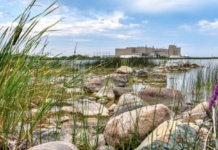This is the time of year when turtles come onto land specifically to lay their eggs and we recently received a photo of a large snapping turtle and thought we would look into the species, finding out some fascinating facts.
“The sandy hill behind our cottage is called ‘turtle hill’ because many turtles lay their eggs there,” says Jeanne McDowall of Elsinore.

In Ontario, females do not begin to breed until they are 17 to 19 years old. They dig a nest in late May or June in an open area, usually one with loose, sandy soil. The nest site is often the side of a road and drivers should be on the lookout as many try to cross roads at this time of year. They will also lay their eggs on an embankment or a shoreline, or almost any area they can excavate. A single clutch usually consists of between 40 and 50 eggs, which hatch in the fall. Hatchlings are two to three centimetres in length. The incubation temperature of the eggs determines the gender of the hatchlings.
Adult snapping turtles have few natural enemies, but both hibernating and young adults are occasionally victims of opportunistic predation by otters and mink. Raccoons, foxes, skunks and opossums often eat snapping turtle eggs.
The life history of the snapping turtle, however, like that of most of Ontario’s turtle species, is characterized by a late age of maturity and a slow reproduction rate, and adults normally live a very long time in the wild – up to 70 years for many individuals. As a result, the loss of even a few adult turtles from a population every year is enough to cause that population to decline, and this makes snapping turtle populations very vulnerable to threats such as road mortality, hunting and poaching.
Approximately 90 percent of their diet consists of dead animal and plant matter, and this species plays an important role in keeping lakes and wetlands clean.
The species has also been designated as a Specially Protected Reptile under the Ontario Fish and Wildlife Conservation Act. These acts offer protection to individuals and their habitat. The habitat of this species is further protected in Ontario by the Provincial Policy Statement under the Planning Act.










